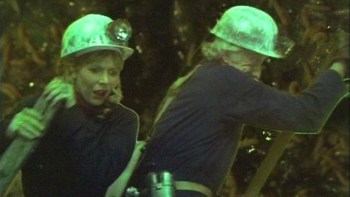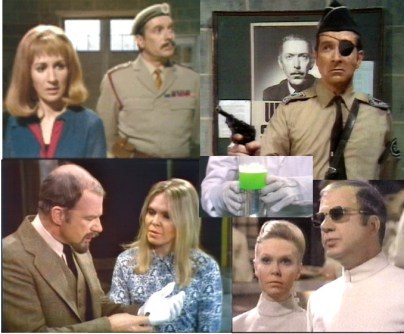Doctor Hue – The Changing Colours of Evil
Bar Nash-Williams is a writer at Kasterborous Doctor Who News and Reviews - All the latest Doctor Who news and reviews with our weekly podKast, features and interviews, and a long-running forum.
Pictures paint a thousand words, and it’s not just artists like me who ‘read’ Who through its colours. Fans’ heads are full of iconic images of the good, the bad, and the downright weird. So what colour do you most associate with monsters and evil? Hands up who said ‘green.’ Some ’70s fans even thought ‘Swarfega’ or ‘bubble-wrap’. But I guess plenty of you said other colours: yes there’s loads to be seen that’s deadly and green, but it’s usually more complicated than that. Green is often merely the symptom: the underlying cause is evil of a different hue. Have a look at these familiar images sorted by colour, and see what they make you think of. How might those colours reflect individual fears, and changes in society’s fears?
‘I’m pretty sure that’s Chroma.’
Let’s just get this out of the way first: Colour Separation Overlay – or Chroma Key, as commonly known – influenced the colour of evil, especially in the early experimental 70s, but not all effects are intentional.
“If any part of an actor or prop is colored the same as the background, that part will disappear… The original run of Doctor Who used green or yellow backgrounds even when blue was the most common color at the BBC, because a large number of its effects shots involved the TARDIS. The problem with using yellow was that foreground objects and actors always had a prominent yellow fringe around them.” http://tvtropes.org/pmwiki/pmwiki.php/Main/ChromaKey
That yellow-green glow was as accidental as the bits of the giant Robot that disappeared because of its reflective surface. Accidents aside however, when there’s something weird, alien or ‘Other’ in Who, there’s
an awful lot of green.
‘Doctor, the thing’s right up your street. The fellow’s bright green apparently. And dead.’
 Sydney Newman didn’t want BEMs – but he got them, second story! As Doug Adams put it:
Sydney Newman didn’t want BEMs – but he got them, second story! As Doug Adams put it:
Arthur: ‘And the bug-eyed monsters?’ Ford: ‘They’re green, yes.’
‘Group Captain Gilmore: What am I dealing with? Little green men?
Seventh Doctor: No, little green blobs in bonded polycarbide armour!’
Kaled mutants may be green, but their world is black and white, grey, colourless and soul-less, reflecting their clinical and dogmatic ideology. Early Doctor Who was broadcast in black and white but it has never thought in black and white. The Doctor always championed nuanced, complex thought over polarised forced simplicity. The thought patterns and attitudes of the baddies are more likely to be characterised by ‘us and them,’ permitted and forbidden, & dogmatic right and wrong. Look at the contrast here, Nyder in Naziesque black, Harry and the Doctor are full colour, and Sarah Jane’s bright green added to the good guys’ side.
Inferno’s another good example – the world which still has some hope has colour; the doomed one is much more monochrome. The green goo is merely ‘the planet, screaming out its rage:’ the problem is the hands it’s in. The 70’s fear of messing about with the elemental forces of the planet, let alone nuclear ones, could only be tamed if we trusted the people in charge. Can you imagine the Brigade Leader or his world’s Stahlman accepting that they might just be WRONG?
Yes I’m green; but I’m one of the nice ones.
The Galaxy 4 Rill are green and ugly, Maarga and co are beautiful but monochrome. Guess who turns out to be good? The Ice warriors challenge to the Doctor’s prejudice is one of the highlights of the Curse of Peladon. The Creature from the Pit is just an unfortunate hostage (it’s been suggested he reflects Freudian fears but I’m not going there!). The Draconians are noble, and the Doctor in the midst of them is green too:
 The Silurians are the most extended example of a green ‘monster’ who are not necessarily bad. The Doctor extends the hand of friendship, but the Silurians are as divided as the humans; some xenophobe, some friendly. Other colours are used as clues to show their nature, for example the red tint to skin and clothes of the warriors. They DON’T all look alike to us! Mme Vastra’s fierce explanation of veil and prejudice in Deep Breath shows that fear of the ‘other’ is not as far behind us as we’d like to believe.
The Silurians are the most extended example of a green ‘monster’ who are not necessarily bad. The Doctor extends the hand of friendship, but the Silurians are as divided as the humans; some xenophobe, some friendly. Other colours are used as clues to show their nature, for example the red tint to skin and clothes of the warriors. They DON’T all look alike to us! Mme Vastra’s fierce explanation of veil and prejudice in Deep Breath shows that fear of the ‘other’ is not as far behind us as we’d like to believe.
Green may be the colour of nature and ecology/environmentalism, but it’s also the colour of gangrene, fungus, pus. So we see stories featuring fear of contamination, infection, loss of control over our bodies.
Which is scarier – totally Alien green Wirrn, or One of Us using alien life for his own ideology? The Seeds of Doom Krynoids are invasive and powerful, but the real baddie is the one whose obsession turns our values on their head: we eat plants, he feeds us to them…
Kenton Moore as Noah really sells this in The Ark in Space
 Note the black, white and grey. All together now: ‘I could play all day in my green cathedral.’
Note the black, white and grey. All together now: ‘I could play all day in my green cathedral.’
Unpleasant body horror recurs in Who, but its emphasis changes. Meglos or Arc of Infinity shows green taking over someone we trust. The Slitheen and Absorbaloff are also body snatchers, but rather than being frightening they are ludicrous, unpleasant, and grossly overweight. At least by Partners in Crime society’s latent prejudice against obesity is marginally better handled: the Adipose are popular cute and cuddlies – even if the story still focuses on the fear of what our lifestyle is doing to us.
The nature of threat and the threat of nature
It looks like the rural/urban shift has changed our attitude to green:
In early Who we had petrified jungles as evidence of apocalypse. When things go wrong green gets hurt and the population suffers. The ‘70s most environmentally conscious story is titled as though green is itself the threat, but the underlying evil is a red, mad supercomputer BOSS of a global corporation. Clifford and friends ‘in tune with nature’ are the good guys.
Colony in Space is from an era when green was good, and the ‘goodies’ are green and brown earth-colour colonists. It was written by Mac Hulke, a politically ‘red’ author, but the planet-raping mining corporation baddies wear red and black! It’s possible to read it these days as green = naïve, and red and black = power; for society to work, you need both sides. In Mark of the Rani we see Luddites opposed to industrial progress, and ‘nature’ attacking Peri. But that nature is weaponised by the Rani as is the industry: neither is bad in itself, only how it is used.
21st century attitude to green is different: yes, environmentalism and ecology are paid more than just lip-service, but literal rather than metaphorical green is more and more alien. Torchwood’s Countrycide had Owen expressing modern urban revulsion at actual green things, and the team terrorised because they are helpless beyond their man-made/controlled, city home.
In Flesh and Stone a forest is artificially created inside a spaceship to provide oxygen for an immensely high-tech world. It is the spooky backdrop to the threat, but contained, controlled.
That use of forest as spooky backdrop in Hide had even the Doctor saying ‘I am afraid.’
 By In the Forest of the Night that green was NOT man-made, contained or controlled: it was taking over the urban environment, even the TARDIS! The fact that it turned out to be the Earth’s salvation doesn’t change the feeling of actual green stuff being threatening. I’d love someone to tell me it was taking over the City’s Square Mile as a reference to the Occupy Movement, but I don’t see it myself. Just like KTM, a great big event happens then everything goes back to just the way it was. Speaking of which…
By In the Forest of the Night that green was NOT man-made, contained or controlled: it was taking over the urban environment, even the TARDIS! The fact that it turned out to be the Earth’s salvation doesn’t change the feeling of actual green stuff being threatening. I’d love someone to tell me it was taking over the City’s Square Mile as a reference to the Occupy Movement, but I don’t see it myself. Just like KTM, a great big event happens then everything goes back to just the way it was. Speaking of which…
Why can’t there just be a big red button?
 Red pulses with extremes: blood is both death and life, fire both dangerous and vibrant.
Red pulses with extremes: blood is both death and life, fire both dangerous and vibrant.
There’s nothing warm about the Axon’s embrace, nor comfort about the blanket from Listen.
The anti-matter monster from Planet of Evil warns of the danger that lurks in the id, the red robes glow with passionate devotion – to the wrong thing.
The Moment’s obliging creation of a BRB brings no more joy than the red balloon – this one isn’t the little girl’s from the Family of Blood; it’s the clown’s from The God Complex. We all know clowns are no laughing matter!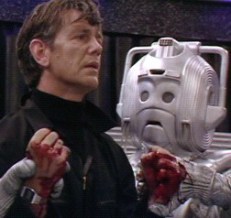
Underlying some of these lurk fears of power, anger (‘seeing red’) or loss of control. Red suggests not the fear of death, but the sticky, gory, painful process of violent death. This (in)famous scene from Attack of the Cybermen was too much for some, but what exactly was it that disturbed us? Would we fear most being agonised Lytton, or the unfeeling Cyberman – our possible future.
As to the tentacles, well if you are interested in the representation of weirdness, do look at Jack Graham’s serious stuff here http://shabogangraffiti.blogspot.co.uk/p/skulltopus.html
We might associate red with danger, but rarely real evil, especially when alongside scary red images, we have so many bright and shining companions: there’s some femmes fatale here too, but more often the colour highlights the connection to life, passion, & warmth which keeps the Doctor going.
Red eyes bring up the issue of what happens when good people and evil combine: a timeless fear of being taken over; or someone we love being replaced by something totally Other. But the eyes aren’t always red, and the scariest possession of all is… …blue.
Blue Shift
How could the colour of these possibly be evil?
 (pause as some of you go off to a happy place…)
(pause as some of you go off to a happy place…)
Before the Eighties we had very little blue in Who; the TARDIS rarely had competition. Metebelis leaps to mind which wasn’t evil in itself. But since the Candyman, and the Destroyer from Battlefield, blue has been deadly. No political implications there, I’m sure…
In the post 2005 series, blue lights up some seriously scary people, but can be friendly too. Maybe it’s the updated version of green faces – with the moral ‘don’t judge a look by its colour.’ We’ve got so used to green aliens in Who that we need something even more alien to disturb us, and blue fits the bill. For now.
Hey, Who turned ON the lights?
I said at the start that Who evil was influenced by the tech they had to create it, and the 21st Century is no different. The cheap, ubiquitous, strong blue light of LEDs has made a significant impact, whether merely reflecting the shift in the built environment we know, or using them to create certain effects.
Whether there are 21st century fears here I’m not convinced. The computer-crash Haiku we loved at the start of this century may be out of date already, but the frustration with unreasonable tech still applies:
Windows 2000 has crashed:
I am the blue screen of death.
No-one hears your screams.
We might associate blue with cold, logical tech, the sort that doesn’t make allowances for human warmth or weakness, and certainly many of these baddies are the epitome of merciless. There’s also a scary element of insanity in these images; the lights are on, but nobody’s home. There’s no-one to reason with.
Blue may turn out to be a passing hue for evil, so let’s return to a classic one.
Mwah ha ha ha…
Some of these stereotype images support the ‘Moffat is sexist/can’t write women’ brigade, but he doesn’t do the costumes. There’s always been a panto element in Who that means the villains have to wear black – from the Meddling Monk to Missy. And even the Doctor was menacing at the start in his black hat and cloak. None as menacing as the chilling Mr Madoc in The War Games – speaking so softly he doesn’t need to carry a stick at all. The epitome of ‘wait till the boss/your father finds out…’ Authority can still scare, and bring out the guilty kid in us. Contrast with the pantoesque War Chief in purple, and ineffectual Security Chief in green. We may have to watch it in B&W, but the cast and crew had these colour references.
Sutekh’s gift of death is delivered in a black package, and the black hats of the Valeyard and the gunslinger hint at executioner, not just ‘bad guy.’ It’s the colour of funerals (in the country and culture that created Doctor Who), body-bags, the grave…. If Who is going to be scary it has to push the buttons that say ‘This person could kill you.’ Whether they keep their menace in an era of ‘Everybody lives, NOT just once, everybody lives’ I doubt. Back in the Buddhist days of Barry Letts re-incarnation meant something; and that included loss, grief, and the end of that actor appearing. If death is no longer an end at all, just a hiatus while the fans speculate HOW that character/actor will return, then black is, frankly, just a bit camp.
But beyond the short-hand ‘black is evil’ idea there’s some more complex stuff the Doctor has to deal with. The Black Guardian is of course, only half of the picture – alone he represents imbalance and chaos not just villainy – and the Doctor isn’t convinced by the Time Lords’ take on the problem. The Valeyard… well; what do you say? How many of us secretly like the Doctor’s Dark Side? Ursula le Guin wasn’t the only one to suggest we acknowledge our shadow lest it hound us for ever.
Other black images show ‘good gone wrong.’ Evangelista is just a glitch in the tech, the black-hat outlaw a person-turned-into-a-weapon-turned-into-a-guardian. Jek’s black AND WHITE unpredictable polarities terrify Peri, but what drove him mad? Even Davros has a past which might account for his personality. Maybe these are a warning of what people become if we don’t take care of them.
White as a Sheet
What better image of taking care of people could there be but a nurse’s uniform, or a scientist’s white coat?
But clinical can be cold, scientists can be mad (‘nusink in ze verld can stop me nooooooow!’), and in a world with amazing developments in drug, bio and gene technology we still fear that whatever is intended to help us might kill us – all. “The trouble with the scientific approach, thought the Brigadier, was that it left you at the mercy of your scientists.” ― Terrance Dicks, Doctor Who and the Auton Invasion
 The Girl Who Waited is a particularly chilling whitescape, because along with the science kill/cure, there’s that blank, empty, directionless, void reminiscent of The Mind Robber and Warrior’s Gate. What can we do when our usual reference points are gone? In the earlier examples our heroes work it out with others. In our densely populated cities and 24/7 social network connections, is our real nightmare like Amy’s? What are we, who are we, if we are totally ALONE?
The Girl Who Waited is a particularly chilling whitescape, because along with the science kill/cure, there’s that blank, empty, directionless, void reminiscent of The Mind Robber and Warrior’s Gate. What can we do when our usual reference points are gone? In the earlier examples our heroes work it out with others. In our densely populated cities and 24/7 social network connections, is our real nightmare like Amy’s? What are we, who are we, if we are totally ALONE?
The traditional white skulls, ghosts and fear of death get plenty of outings in Who, but the emphasis shifts. One theory of ghosts is that they represent (literally re-present) something we’ve repressed, buried in our psych because it’s traumatic. The Ood are a great example of this – slaves, trafficked people, something we can’t free ourselves from until we’ve freed them. Other ghost/skull images hint at a shifting view of death. The ghostly Watcher turned out to be the necessary preparation for death, whereas Simeon’s henchmen are part of his attempt not just to kill the Doctor but to eradicate his whole lives’ experience and influence in the universe. The Silence eradicate our memory/experience even when alive. Annihilation isn’t related to Nihilism for nothing… the unspeakable fear that we might not mean anything, in the next life or this.
 The ‘Host,’ the Destiny disco bots, Light, even clowns are wolves in sheeps’ clothing, the white apparel is a lie. The android angel is literally two-faced here – try covering the right side of the im
The ‘Host,’ the Destiny disco bots, Light, even clowns are wolves in sheeps’ clothing, the white apparel is a lie. The android angel is literally two-faced here – try covering the right side of the im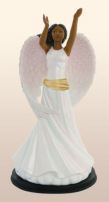 age, then the left. The lighting even brings out the skull shape – arghhh! If we can’t trust the ‘white hats,’ who can we trust?
age, then the left. The lighting even brings out the skull shape – arghhh! If we can’t trust the ‘white hats,’ who can we trust?
Silence in the Library/Forest of the Dead is another glimpse of 21st century belief. The Vashta Nerada are explained as a rational fear of the dark, in a society that hardly ever experiences real darkness – but what happens if power rationing does turn out the lights?
The ‘saved’ archaeologist team are dressed in angelic white, with River even lit with a heavenly glow. Moffat’s unwillingness to actually kill anyone turns them into ‘guardian angel’ figurine lookalikes, throwbacks to a meaning modern western society has made sentimental.
Grey Men – ‘You will become like us.’
 The development in Cyberman images are another glimpse into modern culture. The cyber-moondance is delightful, but the early fabric-faced monsters were scary because they were us, with most of what makes us human torn away, but just enough left to warn us. By the Age of Steel every hint of uniqueness or human origin is gone, so they are robotic (note the blue light on the modern ones).
The development in Cyberman images are another glimpse into modern culture. The cyber-moondance is delightful, but the early fabric-faced monsters were scary because they were us, with most of what makes us human torn away, but just enough left to warn us. By the Age of Steel every hint of uniqueness or human origin is gone, so they are robotic (note the blue light on the modern ones).
Isobel’s photo of fallen cybermen contrasts beautifully with the regimented soldiers behind her, and with the social-media trending event staged my Missy. We’ve gone from identity to identical, then Self-less to Selfie. They’re hollow men and hollow threat. So the reveal of CyberDanny and the contentious CyberBrig is a disturbing move – they’re not hollow or identical or un-human after all, but re-animated corpses. Yet another way of bringing back dead characters, but no resurrection any of us would choose.
 The mummies in Pyramids of Mars aren’t really walking dead, but Marcus Scarman is, and therefore much scarier – he’s more like us, so we could be like him. The Foretold ends up being a creature we feel sorry for, in contrast with the evil ‘Gus’ shown only as a blue-lit screen. Weeping Angels beat all ‘monsters with a heart of stone’ but note the repeated contrast with the companions’ colours: we need to assert our difference from them. The cosplay ‘Amy’ shows this fear well – what happens if we become them?
The mummies in Pyramids of Mars aren’t really walking dead, but Marcus Scarman is, and therefore much scarier – he’s more like us, so we could be like him. The Foretold ends up being a creature we feel sorry for, in contrast with the evil ‘Gus’ shown only as a blue-lit screen. Weeping Angels beat all ‘monsters with a heart of stone’ but note the repeated contrast with the companions’ colours: we need to assert our difference from them. The cosplay ‘Amy’ shows this fear well – what happens if we become them?
Thinking of that other classic grey monster, note how much colour has warmed up Sontarans recently – contrast the pasty grey heart-of-stone baddie, to the shiny blue ally with flesh tones so much closer to our own… In some ways we seem to have turned the Cybermen’s threat around, saying to the monsters: ‘you will become like us.’
 Talking of our own flesh, the grey adipose tissue becomes cute, and so irresistibly re-creatable with marshmallows. Just as death seems to have been annulled, threat is tamed.
Talking of our own flesh, the grey adipose tissue becomes cute, and so irresistibly re-creatable with marshmallows. Just as death seems to have been annulled, threat is tamed.
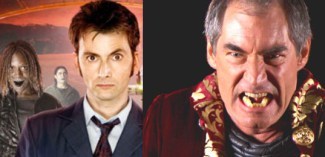 The Waters of Mars is an interesting contrast – the people get greyer as they are taken over, but by the end the scariest part was Him: as Adelaide says, ‘the Time Lord Victorious is wrong.’ The Time Lord victorious is … Rassilon!
The Waters of Mars is an interesting contrast – the people get greyer as they are taken over, but by the end the scariest part was Him: as Adelaide says, ‘the Time Lord Victorious is wrong.’ The Time Lord victorious is … Rassilon!
Back to the red of power gone mad…
Power gone stale is beautifully played by Martin Jarvis in Vengeance on Varos, and ruthlessly pilloried by Bob Holmes in Carnival of Monsters. And here the contrasts are brighter than ever.
Sometimes the message is intended to be profound, like the Third Doctor’s ‘daisiest daisy’: ‘All bleak and cold, some few bare rocks with some weeds sprouting from them, and some pathetic little patches of sludgy snow. It was just grey. Grey, grey, grey. …suddenly I saw it through his eyes. It was simply glowing with life, like a perfectly cut jewel, and the colours… the colours were deeper and richer than anything you could possibly imagine. Yes, it was the daisiest daisy I’d ever seen. … ‘I found that the rocks weren’t grey at all. They were red, brown and purple gold. And those pathetic little patches of sludgy snow, they were shining white. Shining white with sunlight…’
Occasionally the message is pretty simple: It’s what’s inside that counts.
The baddies in The Mutants were black to the core, whereas that Mutts were merely waiting to mutate…
Nobody likes Tangerine
Bright is not always right, however…
The less said about the Victory of the Daleks the better (except that it’s hard to take multicoloured evil seriously). Toys can be scary, but they have to be a lot more menacing than this.
The tartrazine Happiness Patrol glowed with pink, but was BOTH extolling The Blues (feeling blue and expressing it), and satirizing the Thatcher Tory administration. The big bad was the ideology that sought to control/use people’s emotions. Much like the Rani in Mark of, and the Mara (Kinda/Snakedance). Yellow and orange evil are as rare as pink. Terror of the Autons does stand out, for these guys and the daffodils. Vincent’s sunflowers are an interesting angle: ‘Always somewhere between living and dying. Half-human as they turn to the sun. A little disgusting.’
There seem to be quite a few Doctor Who baddies/monsters that are brightly-coloured, but wearing masks; anything that superficially appealing must be fake; tempting but bad for you. Under the fantastic plastic cheap consumer goods lies the hungry Nestene consciousness which will swallow you up.
All these sweetshop colours hint that we’ll be sick later – ‘it’ll all end in tears.’ In The Happiness Patrol the sweets kill you; in Autons the consumer goods consume you; rich seedheads of sunflowers are ‘disgusting;’ The Axon tempts earth with an all-you-can-eat magic porridge pot, even in the concourse scene of The Long Game you get that theme of what happens if we over-indulge in whatever tempts us, that led to Adam’s rejection by the Doctor. 11 let the Akhaten pumpkin ‘have it all,’ but he wasn’t only using over-indulgence to kill the monster, he was jettisoning some stuff he’d been carrying too long. When you put images of Gallifrey alongside you do wonder if part of what the Doctor was purging was his less pleasant memories of home. I hope when he finds it again there’ll be something worth restoring.
So, there’s a starter for ten, from one perspective. How do others read the hues of Who, which colours still evoke an emotional reaction, and do any images still have the power to disturb?
The post Doctor Hue – The Changing Colours of Evil appeared first on Kasterborous Doctor Who News and Reviews.
Christian Cawley's Blog
- Christian Cawley's profile
- 4 followers


